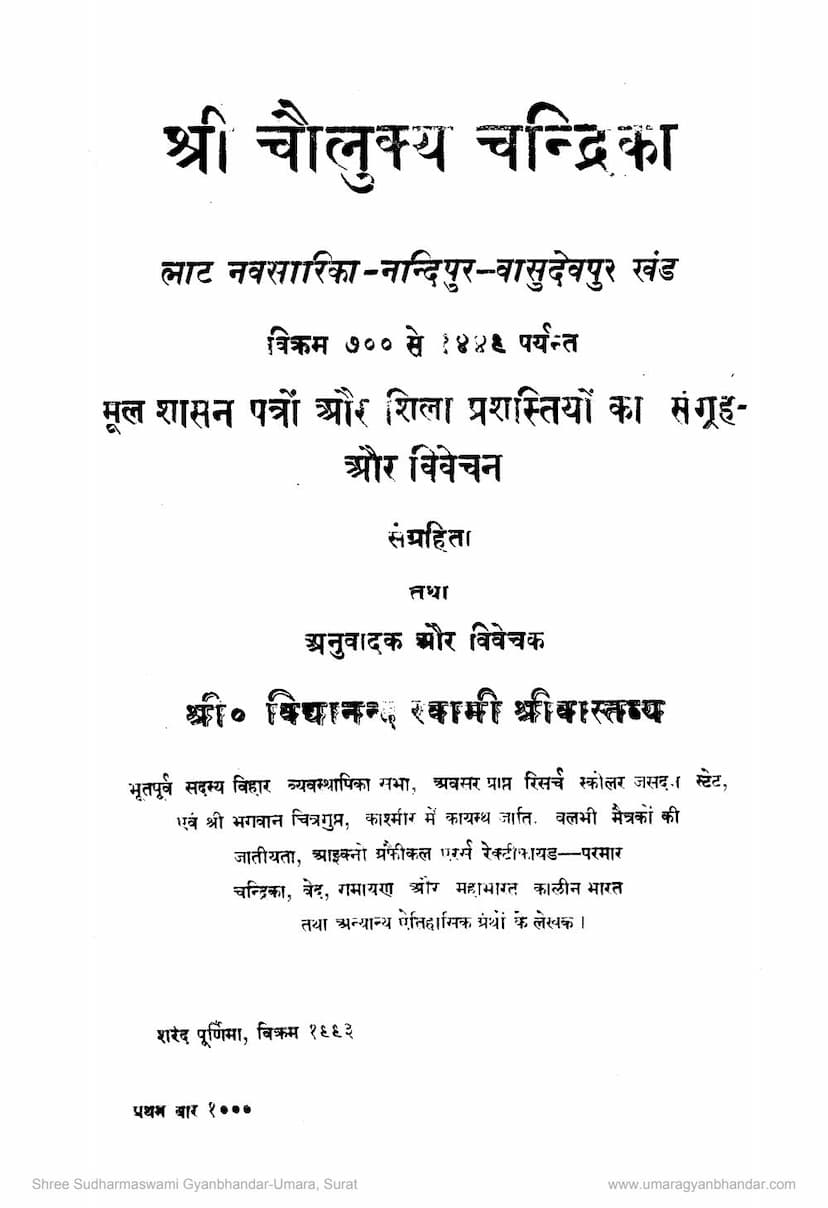Chaulukya Chandrika
Added to library: September 1, 2025

Summary
This document is the "Chaulukya Chandrika," a collection and analysis of original inscriptions and stone edicts related to the Chaulukya dynasty, specifically focusing on the Lata region (including Navasari, Nandi pur, and Vasudevpur) from the 7th to the 15th century Vikram era. Authored and compiled by Vidyanandswami Shreevastavya, it aims to provide a comprehensive historical account based on primary sources.
The text begins with a detailed preface that discusses the importance of understanding the history of a region and its ruling dynasties before delving into specific details. It begins by examining the historical names of regions like Gujarat and Lata, tracing their geographical boundaries and previous designations in ancient texts like the Puranas, Ramayana, and Mahabharata.
A significant portion of the early chapters focuses on the etymology and geographical extent of the "Laṭa" region. It discusses the rivers that defined its borders and the various kingdoms and dynasties that ruled the area before the Chaulukyas, including the Gurjaras, Maitrakas, Rashtrakutas, Guhilas, and Muslims. The author meticulously analyzes historical records, inscriptions, and travelers' accounts to establish timelines and identify the rise and fall of these ruling powers.
The core of the book then delves into the history of the Chaulukyas in the Lata region, categorizing their presence into three indirect and three direct forms of influence:
- Indirect Relations:
- Supremacy of the rulers of Vatapi.
- Supremacy of the rulers of Vatapi-Kalyani.
- Supremacy of the rulers of Patan.
- Direct Relations:
- Chaulukyas of Navasari.
- Chaulukyas of Nandi pur.
- Chaulukyas of Vasudevpur.
The author presents and analyzes several key inscriptions and copper plate grants, providing their lithological and linguistic details, along with critical commentary. These analyses help establish the genealogy, reign periods, administrative divisions, and significant events of the Chaulukya rulers and their contemporaries.
Specific inscriptions discussed include:
- Yuvraj Shiladitya's Grant: This inscription from Navasari is analyzed for its genealogical information, establishing a lineage from Pulakeshi Vallabha to Shiladitya. The author discusses potential discrepancies with other genealogies and the interpretation of certain epithets.
- Janaashray Pulakeshi's Grant: This inscription, also from Navasari, is crucial for understanding the early Chaulukyas of Lata and their interactions with Arab incursions. The author meticulously reconstructs the historical context of these events.
- Trilochana Pal's Grant: This inscription details the history and genealogy of the Chaulukyas of Nandi pur, tracing their lineage from Varpadeva. It highlights their political activities, administrative structure, and land grants.
- Vir Singh's Grant: This inscription from Vasudevpur details the lineage of the Chaulukyas of Vasudevpur, their capital shifts, and their interactions with other contemporary powers.
- Karna Deva's Grant: This inscription provides further genealogical details and discusses land grants made for religious purposes.
- Hule Gundi Prashasti: This inscription is analyzed to shed light on Jayasimha's activities and his relations with other dynasties like the Kadambas and Chalukyas of Kalyani.
- Aragiri Prashasti and Neralgundi Prashasti: These inscriptions provide insights into Jayasimha's regional influence and administrative actions.
- Tumbara Hosuru Ramashwar Temple Inscription: This inscription is analyzed for its genealogical details, administrative practices, and geographical references related to Jayasimha.
- Tumbara Hosuru Tamarind Tree Inscription: This inscription is examined for its historical context and the possible locations of ancient settlements.
- Vasudevpur Raj Prashasti: This extensive inscription provides a detailed genealogy of the Vasudevpur Chaulukyas, along with descriptions of their capital city and significant rulers.
- Karna Deva's Grant (Vikram Samvat 1277): This inscription provides genealogical information and details about land grants, offering insights into the administration and religious practices of the period.
- Krishnananda's Inscription: This inscription discusses the construction of a Shiva temple and mentions the patronage received from the Chaulukya queen.
The text also includes a significant section on the Maratha and later the British periods, discussing their influence and control over the region. It details the complex political landscape, the rise of the Peshwas, the conflicts among Maratha factions, and the eventual establishment of British dominion. The author uses historical records and tradition to outline the genealogies and key events of these periods as they relate to the Lata region.
Throughout the book, the author emphasizes the importance of critically evaluating historical sources, comparing different inscriptions, and cross-referencing with external historical accounts. He engages with the interpretations of previous scholars, both Indian and Western, offering his own critical analysis and often proposing alternative perspectives based on his in-depth study of the primary materials. The author's extensive knowledge of various historical scripts, languages, and dynastic histories is evident in his detailed and nuanced discussions.